Abstract
The sympathetic nervous system is recognized to play a role in the etiology of animal and possibly human obesity through its impact on energy expenditure and/or food intake. We, therefore, measured fasting muscle sympathetic nerve activity (MSNA) in the peroneal nerve and its relationship with energy expenditure and body composition in 25 relatively lean Pima Indian males (means +/- SD; 26 +/- 6 yr, 82 +/- 19 kg, 28 +/- 10% body fat) and 19 Caucasian males (29 +/- 5 yr, 81 +/- 13 kg, 24 +/- 9% body fat). 24-h energy expenditure, sleeping metabolic rate, and resting metabolic rate were measured in a respiratory chamber, whereas body composition was estimated by hydrodensitometry. Pima Indians had lower MSNA than Caucasians (23 +/- 6 vs 33 +/- 10 bursts/min, P = 0.0007). MSNA was significantly related to percent body fat in Caucasians (r = 0.55, P = 0.01) but not in Pimas. MSNA also correlated with energy expenditure adjusted for fat-free mass, fat mass, and age in Caucasians (r = 0.51, P = 0.03; r = 0.54, P = 0.02; and r = 0.53, P = 0.02 for adjusted 24-h energy expenditure, sleeping metabolic rate, and resting metabolic rate, respectively) but not in Pima Indians. In conclusion, the activity of the sympathetic nervous system is a determinant of energy expenditure in Caucasians. Individuals with low resting MSNA may be at risk for body weight gain resulting from a lower metabolic rate. A low resting MSNA and the lack of impact of MSNA on metabolic rate might play a role in the etiology of obesity in Pima Indians.
Full text
PDF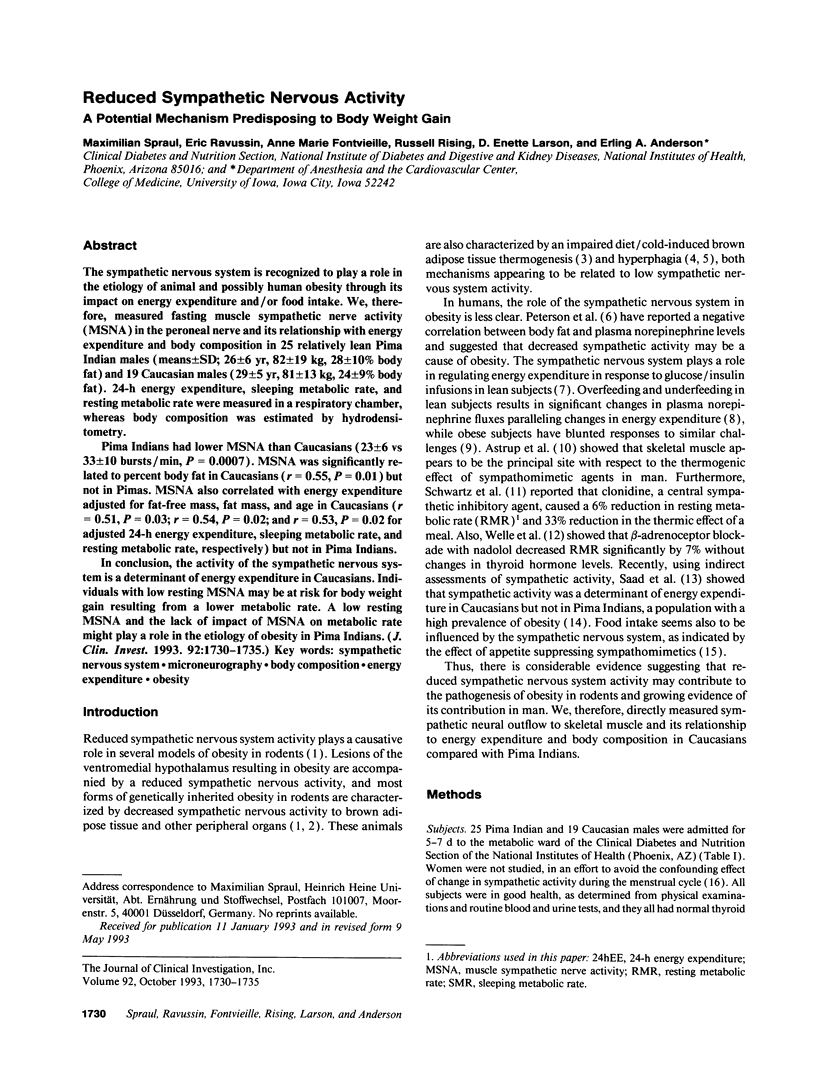
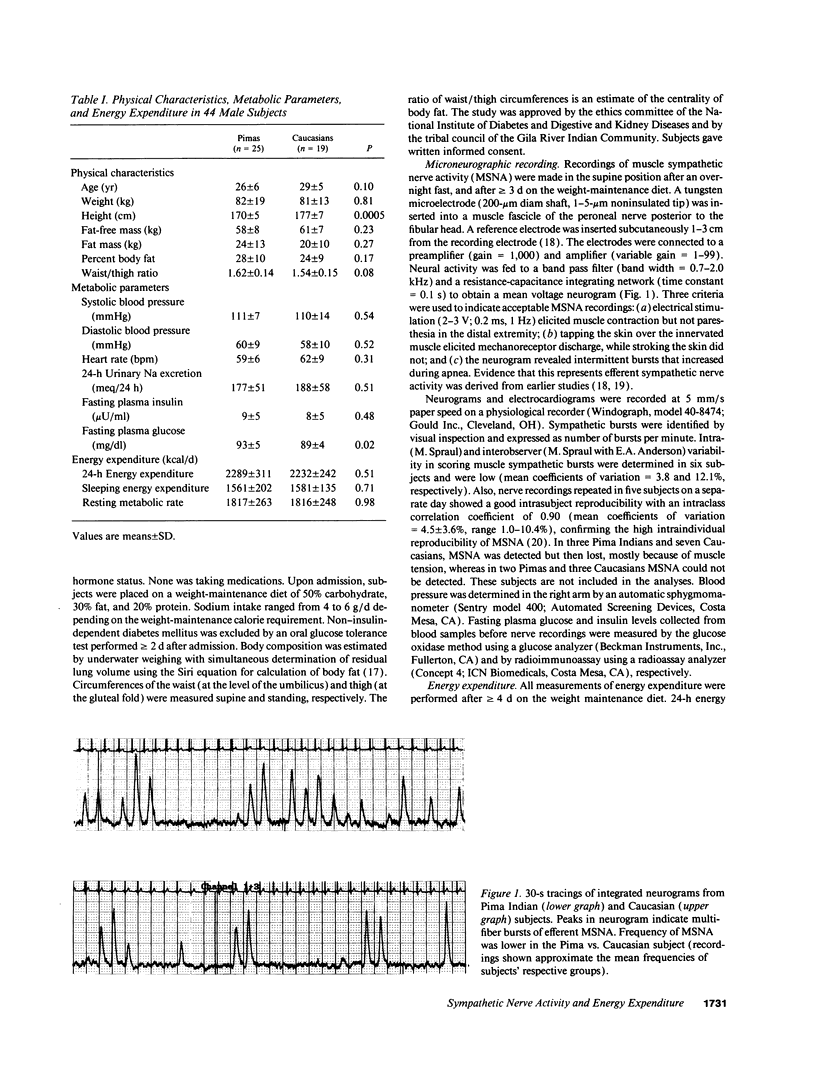
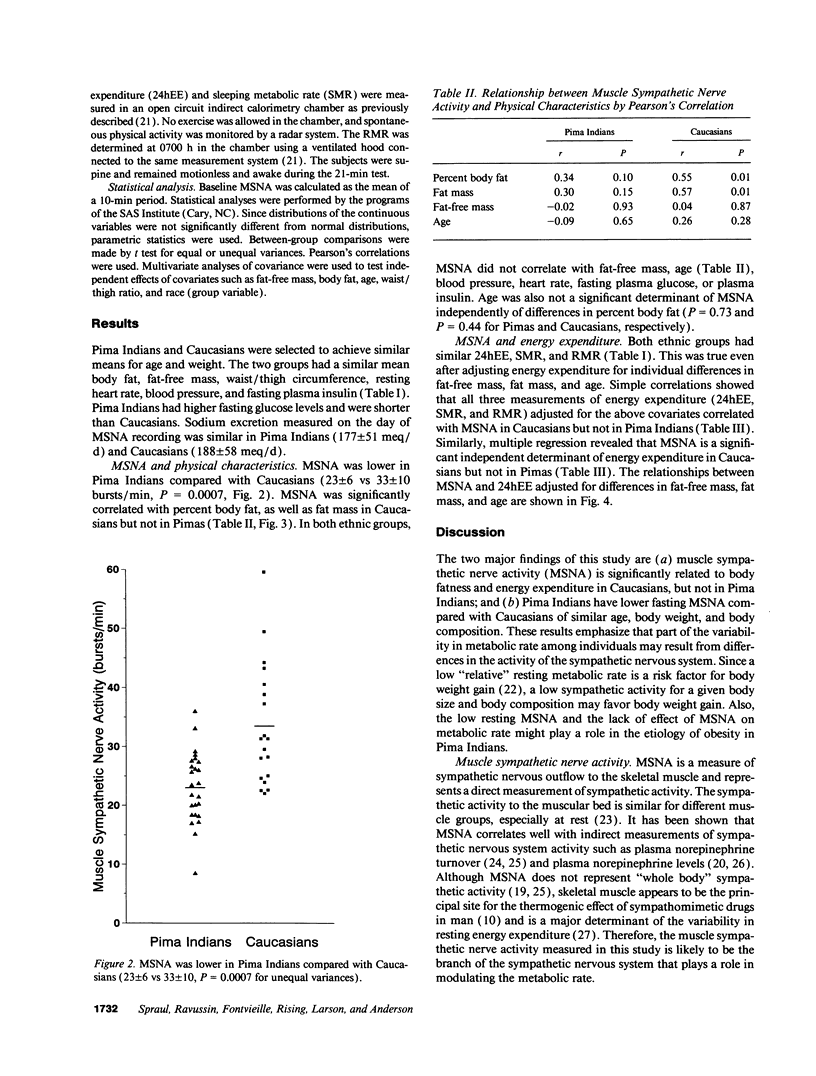
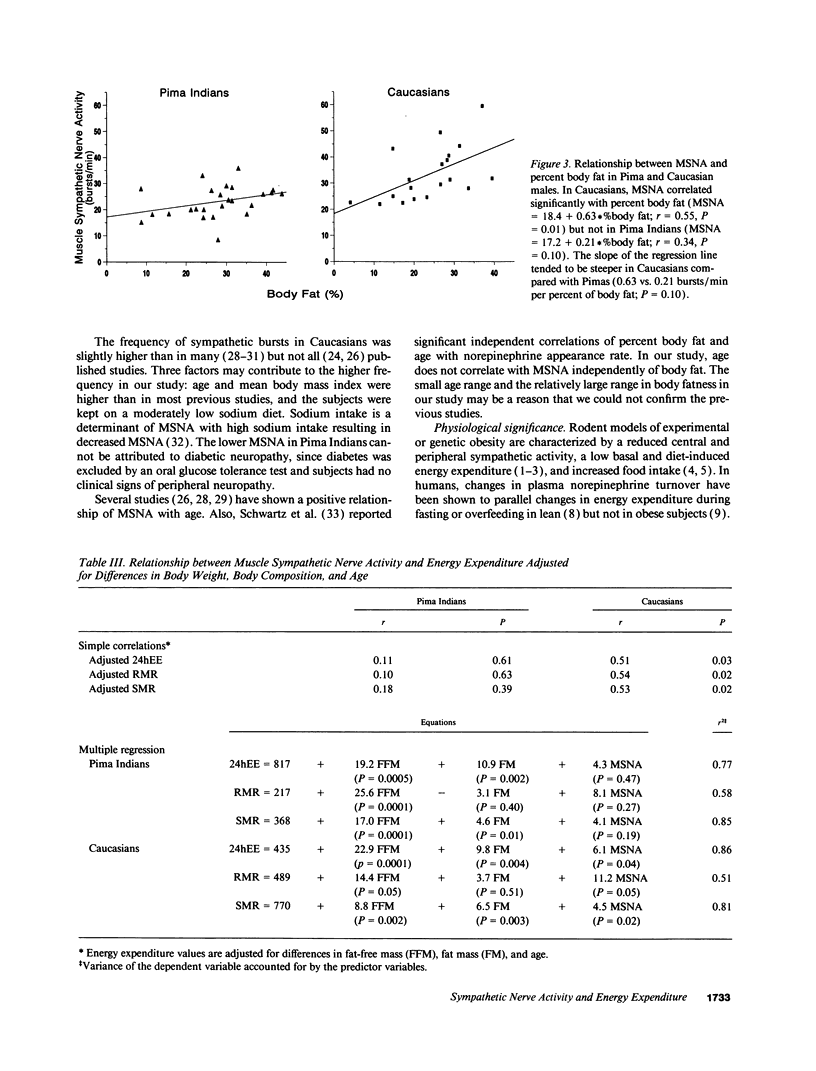
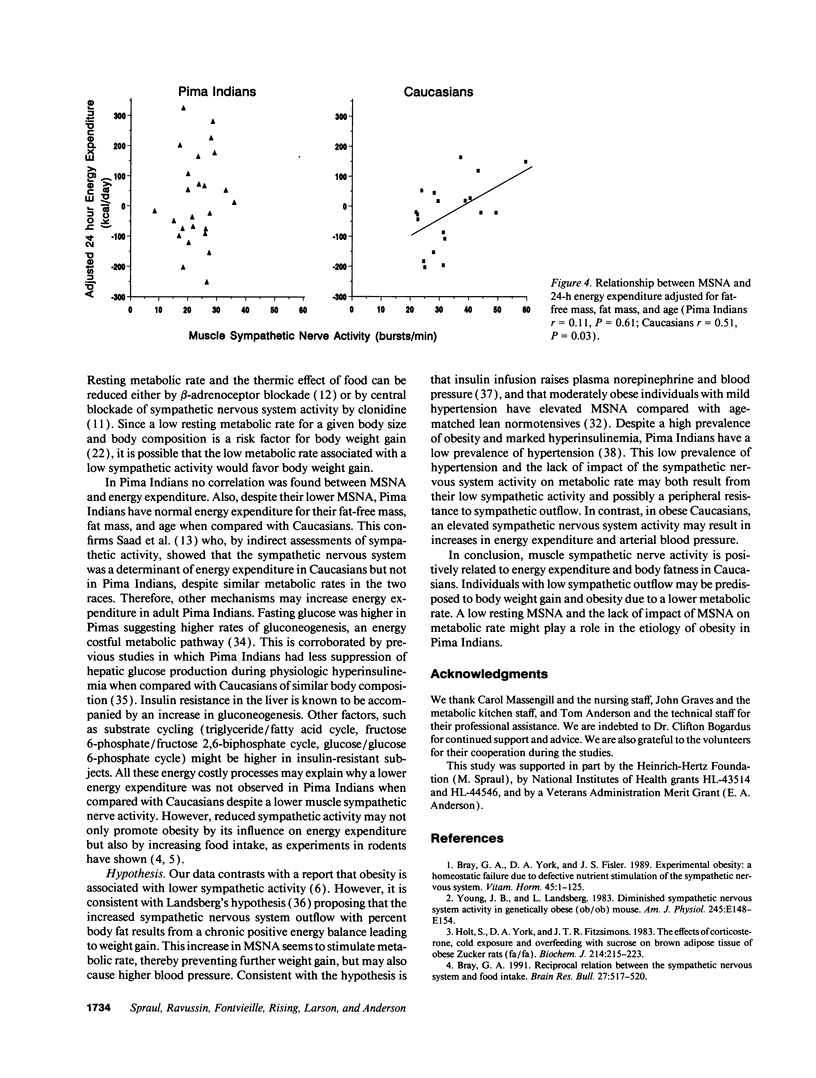
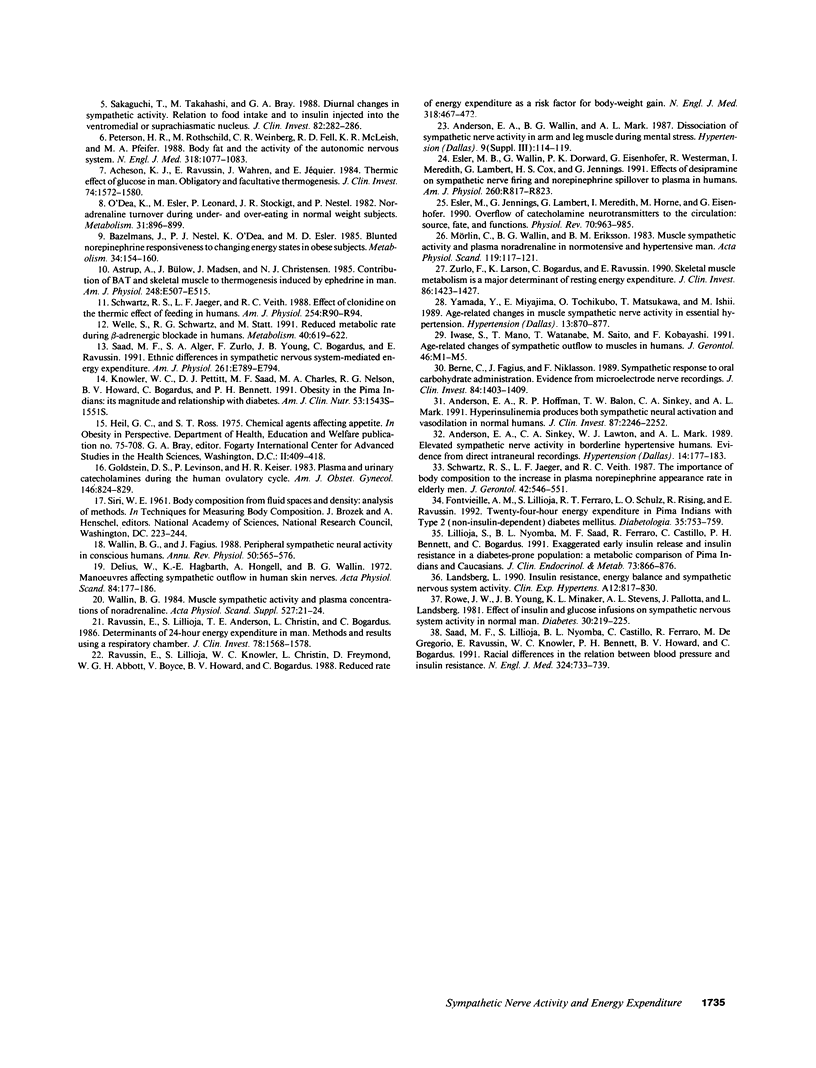
Selected References
These references are in PubMed. This may not be the complete list of references from this article.
- Acheson K. J., Ravussin E., Wahren J., Jéquier E. Thermic effect of glucose in man. Obligatory and facultative thermogenesis. J Clin Invest. 1984 Nov;74(5):1572–1580. doi: 10.1172/JCI111573. [DOI] [PMC free article] [PubMed] [Google Scholar]
- Anderson E. A., Hoffman R. P., Balon T. W., Sinkey C. A., Mark A. L. Hyperinsulinemia produces both sympathetic neural activation and vasodilation in normal humans. J Clin Invest. 1991 Jun;87(6):2246–2252. doi: 10.1172/JCI115260. [DOI] [PMC free article] [PubMed] [Google Scholar]
- Anderson E. A., Sinkey C. A., Lawton W. J., Mark A. L. Elevated sympathetic nerve activity in borderline hypertensive humans. Evidence from direct intraneural recordings. Hypertension. 1989 Aug;14(2):177–183. doi: 10.1161/01.hyp.14.2.177. [DOI] [PubMed] [Google Scholar]
- Astrup A., Bülow J., Madsen J., Christensen N. J. Contribution of BAT and skeletal muscle to thermogenesis induced by ephedrine in man. Am J Physiol. 1985 May;248(5 Pt 1):E507–E515. doi: 10.1152/ajpendo.1985.248.5.E507. [DOI] [PubMed] [Google Scholar]
- Bazelmans J., Nestel P. J., O'Dea K., Esler M. D. Blunted norepinephrine responsiveness to changing energy states in obese subjects. Metabolism. 1985 Feb;34(2):154–160. doi: 10.1016/0026-0495(85)90125-8. [DOI] [PubMed] [Google Scholar]
- Berne C., Fagius J., Niklasson F. Sympathetic response to oral carbohydrate administration. Evidence from microelectrode nerve recordings. J Clin Invest. 1989 Nov;84(5):1403–1409. doi: 10.1172/JCI114313. [DOI] [PMC free article] [PubMed] [Google Scholar]
- Bray G. A. Reciprocal relation between the sympathetic nervous system and food intake. Brain Res Bull. 1991 Sep-Oct;27(3-4):517–520. doi: 10.1016/0361-9230(91)90152-a. [DOI] [PubMed] [Google Scholar]
- Bray G. A., York D. A., Fisler J. S. Experimental obesity: a homeostatic failure due to defective nutrient stimulation of the sympathetic nervous system. Vitam Horm. 1989;45:1–125. doi: 10.1016/s0083-6729(08)60393-3. [DOI] [PubMed] [Google Scholar]
- Delius W., Hagbarth K. E., Hongell A., Wallin B. G. Manoeuvres affecting sympathetic outflow in human skin nerves. Acta Physiol Scand. 1972 Feb;84(2):177–186. doi: 10.1111/j.1748-1716.1972.tb05168.x. [DOI] [PubMed] [Google Scholar]
- Esler M. D., Wallin G., Dorward P. K., Eisenhofer G., Westerman R., Meredith I., Lambert G., Cox H. S., Jennings G. Effects of desipramine on sympathetic nerve firing and norepinephrine spillover to plasma in humans. Am J Physiol. 1991 Apr;260(4 Pt 2):R817–R823. doi: 10.1152/ajpregu.1991.260.4.R817. [DOI] [PubMed] [Google Scholar]
- Esler M., Jennings G., Lambert G., Meredith I., Horne M., Eisenhofer G. Overflow of catecholamine neurotransmitters to the circulation: source, fate, and functions. Physiol Rev. 1990 Oct;70(4):963–985. doi: 10.1152/physrev.1990.70.4.963. [DOI] [PubMed] [Google Scholar]
- Fontvieille A. M., Lillioja S., Ferraro R. T., Schulz L. O., Rising R., Ravussin E. Twenty-four-hour energy expenditure in Pima Indians with type 2 (non-insulin-dependent) diabetes mellitus. Diabetologia. 1992 Aug;35(8):753–759. doi: 10.1007/BF00429096. [DOI] [PubMed] [Google Scholar]
- Goldstein D. S., Levinson P., Keiser H. R. Plasma and urinary catecholamines during the human ovulatory cycle. Am J Obstet Gynecol. 1983 Aug 1;146(7):824–829. doi: 10.1016/0002-9378(83)91086-4. [DOI] [PubMed] [Google Scholar]
- Holt S., York D. A., Fitzsimons J. T. The effects of corticosterone, cold exposure and overfeeding with sucrose on brown adipose tissue of obese Zucker rats (fa/fa). Biochem J. 1983 Jul 15;214(1):215–223. doi: 10.1042/bj2140215. [DOI] [PMC free article] [PubMed] [Google Scholar]
- Iwase S., Mano T., Watanabe T., Saito M., Kobayashi F. Age-related changes of sympathetic outflow to muscles in humans. J Gerontol. 1991 Jan;46(1):M1–M5. doi: 10.1093/geronj/46.1.m1. [DOI] [PubMed] [Google Scholar]
- Knowler W. C., Pettitt D. J., Saad M. F., Charles M. A., Nelson R. G., Howard B. V., Bogardus C., Bennett P. H. Obesity in the Pima Indians: its magnitude and relationship with diabetes. Am J Clin Nutr. 1991 Jun;53(6 Suppl):1543S–1551S. doi: 10.1093/ajcn/53.6.1543S. [DOI] [PubMed] [Google Scholar]
- Landsberg L. Insulin resistance, energy balance and sympathetic nervous system activity. Clin Exp Hypertens A. 1990;12(5):817–830. doi: 10.3109/10641969009073502. [DOI] [PubMed] [Google Scholar]
- Lillioja S., Nyomba B. L., Saad M. F., Ferraro R., Castillo C., Bennett P. H., Bogardus C. Exaggerated early insulin release and insulin resistance in a diabetes-prone population: a metabolic comparison of Pima Indians and Caucasians. J Clin Endocrinol Metab. 1991 Oct;73(4):866–876. doi: 10.1210/jcem-73-4-866. [DOI] [PubMed] [Google Scholar]
- Mörlin C., Wallin B. G., Eriksson B. M. Muscle sympathetic activity and plasma noradrenaline in normotensive and hypertensive man. Acta Physiol Scand. 1983;119(2):117–121. doi: 10.1111/j.1748-1716.1983.tb07315.x. [DOI] [PubMed] [Google Scholar]
- O'Dea K., Esler M., Leonard P., Stockigt J. R., Nestel P. Noradrenaline turnover during under- and over-eating in normal weight subjects. Metabolism. 1982 Sep;31(9):896–899. doi: 10.1016/0026-0495(82)90178-0. [DOI] [PubMed] [Google Scholar]
- Peterson H. R., Rothschild M., Weinberg C. R., Fell R. D., McLeish K. R., Pfeifer M. A. Body fat and the activity of the autonomic nervous system. N Engl J Med. 1988 Apr 28;318(17):1077–1083. doi: 10.1056/NEJM198804283181701. [DOI] [PubMed] [Google Scholar]
- Ravussin E., Lillioja S., Anderson T. E., Christin L., Bogardus C. Determinants of 24-hour energy expenditure in man. Methods and results using a respiratory chamber. J Clin Invest. 1986 Dec;78(6):1568–1578. doi: 10.1172/JCI112749. [DOI] [PMC free article] [PubMed] [Google Scholar]
- Ravussin E., Lillioja S., Knowler W. C., Christin L., Freymond D., Abbott W. G., Boyce V., Howard B. V., Bogardus C. Reduced rate of energy expenditure as a risk factor for body-weight gain. N Engl J Med. 1988 Feb 25;318(8):467–472. doi: 10.1056/NEJM198802253180802. [DOI] [PubMed] [Google Scholar]
- Rowe J. W., Young J. B., Minaker K. L., Stevens A. L., Pallotta J., Landsberg L. Effect of insulin and glucose infusions on sympathetic nervous system activity in normal man. Diabetes. 1981 Mar;30(3):219–225. doi: 10.2337/diab.30.3.219. [DOI] [PubMed] [Google Scholar]
- Saad M. F., Alger S. A., Zurlo F., Young J. B., Bogardus C., Ravussin E. Ethnic differences in sympathetic nervous system-mediated energy expenditure. Am J Physiol. 1991 Dec;261(6 Pt 1):E789–E794. doi: 10.1152/ajpendo.1991.261.6.E789. [DOI] [PubMed] [Google Scholar]
- Saad M. F., Lillioja S., Nyomba B. L., Castillo C., Ferraro R., De Gregorio M., Ravussin E., Knowler W. C., Bennett P. H., Howard B. V. Racial differences in the relation between blood pressure and insulin resistance. N Engl J Med. 1991 Mar 14;324(11):733–739. doi: 10.1056/NEJM199103143241105. [DOI] [PubMed] [Google Scholar]
- Sakaguchi T., Takahashi M., Bray G. A. Diurnal changes in sympathetic activity. Relation to food intake and to insulin injected into the ventromedial or suprachiasmatic nucleus. J Clin Invest. 1988 Jul;82(1):282–286. doi: 10.1172/JCI113584. [DOI] [PMC free article] [PubMed] [Google Scholar]
- Schwartz R. S., Jaeger L. F., Veith R. C. Effect of clonidine on the thermic effect of feeding in humans. Am J Physiol. 1988 Jan;254(1 Pt 2):R90–R94. doi: 10.1152/ajpregu.1988.254.1.R90. [DOI] [PubMed] [Google Scholar]
- Schwartz R. S., Jaeger L. F., Veith R. C. The importance of body composition to the increase in plasma norepinephrine appearance rate in elderly men. J Gerontol. 1987 Sep;42(5):546–551. doi: 10.1093/geronj/42.5.546. [DOI] [PubMed] [Google Scholar]
- Wallin B. G., Fagius J. Peripheral sympathetic neural activity in conscious humans. Annu Rev Physiol. 1988;50:565–576. doi: 10.1146/annurev.ph.50.030188.003025. [DOI] [PubMed] [Google Scholar]
- Wallin B. G. Muscle sympathetic activity and plasma concentrations of noradrenaline. Acta Physiol Scand Suppl. 1984;527:21–24. [PubMed] [Google Scholar]
- Welle S., Schwartz R. G., Statt M. Reduced metabolic rate during beta-adrenergic blockade in humans. Metabolism. 1991 Jun;40(6):619–622. doi: 10.1016/0026-0495(91)90053-y. [DOI] [PubMed] [Google Scholar]
- Yamada Y., Miyajima E., Tochikubo O., Matsukawa T., Ishii M. Age-related changes in muscle sympathetic nerve activity in essential hypertension. Hypertension. 1989 Jun;13(6 Pt 2):870–877. doi: 10.1161/01.hyp.13.6.870. [DOI] [PubMed] [Google Scholar]
- Young J. B., Landsberg L. Diminished sympathetic nervous system activity in genetically obese (ob/ob) mouse. Am J Physiol. 1983 Aug;245(2):E148–E154. doi: 10.1152/ajpendo.1983.245.2.E148. [DOI] [PubMed] [Google Scholar]
- Zurlo F., Larson K., Bogardus C., Ravussin E. Skeletal muscle metabolism is a major determinant of resting energy expenditure. J Clin Invest. 1990 Nov;86(5):1423–1427. doi: 10.1172/JCI114857. [DOI] [PMC free article] [PubMed] [Google Scholar]


